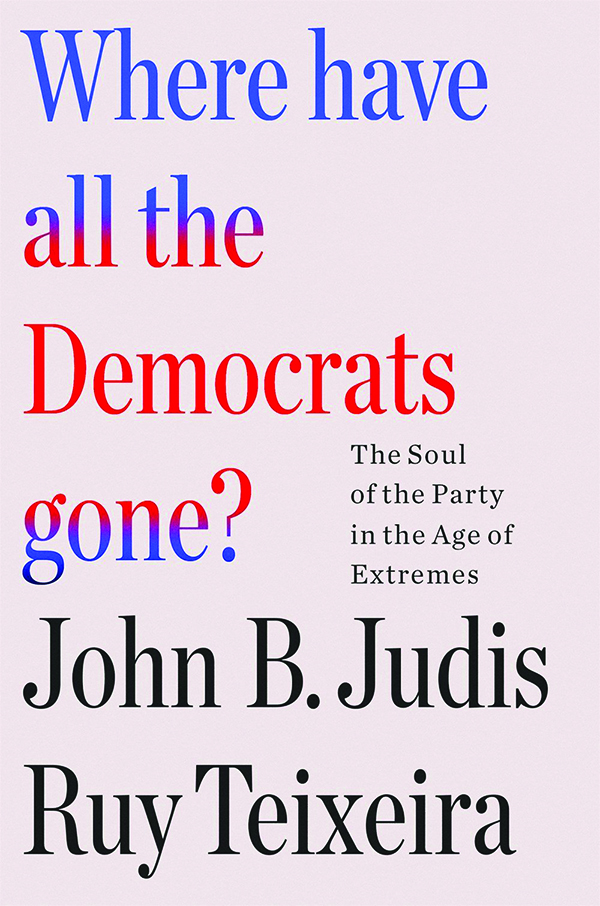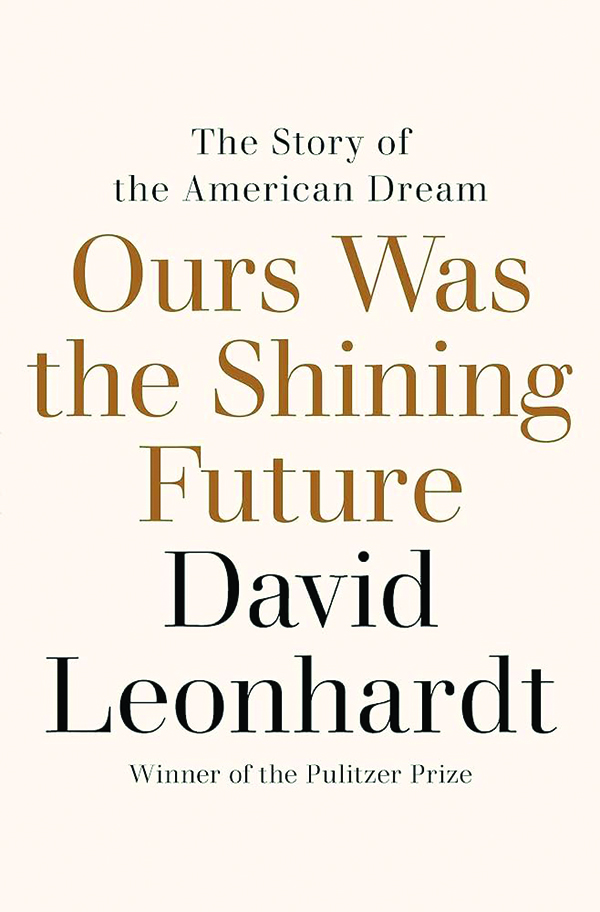
Democrats get some unsolicited advice for Christmas
Derek Robertson
Americans are unhappy.
OK, I’ll be more specific: Democrats are especially unhappy right now, mystified and bereft that President Joe Biden is consistently underperforming in 2024 polls despite his likely opponent’s unpopularity. While overperforming in the 2022 midterm elections and November’s special elections, as well as notching a slate of victories on abortion-related ballot initiatives from Kentucky to Montana, Democrats’ continuing anxiety about 2020 is best channeled by David Axelrod, speaking recently to Maureen Dowd: “They’ve got a real problem if they’re counting on Trump to win it for them. I remember Hillary doing that, too.”

Liberals should heed his warning. Public sentiment toward Biden and his party is dire, at least for the moment: A mid-November YouGov/Economist poll showed that only a quarter of Democrats want Biden to run for reelection. The president has started to lag consistently in polling behind his predecessor, despite the phalanx of criminal charges the latter might face. Most perplexingly to Democratic partisans, voters remain stubbornly resistant to the “good” economic news that’s characterized Biden’s first term, largely viewing the economy as getting worse despite a strong labor market and rising wages.
YOUR NEXT NEW CAR WILL BE OLD WHEN YOU BUY IT
Two books released this fall from veteran liberal observers present largely overlapping explanations for why this is the case. Where Have All The Democrats Gone? by the writer John Judis and political scientist Ruy Teixeira and Ours Was The Shining Future, by New York Times columnist David Leonhardt, both make a case that Democrats have hobbled themselves electorally by turning a blind eye to the working class. Although their lens and focus might differ, the two books argue that cultural and demographic trends since the 1960s have led the Democratic Party to favor today’s cultural Brahmins — let’s just say it, yuppies — over its traditional base of blue-collar and minority workers.
Judis and Teixeira’s book carries particular weight because they predicted this exact phenomenon, just not the extremes it would reach. In 2002, the two teamed up to write The Emerging Democratic Majority, which foretold an influx of young, minority, highly educated, largely female voters into the titular party, which would ensure its ongoing dominance over electoral politics in years to come. That is, as long as they didn’t hemorrhage too much of their original base, which they didn’t in 2008 because this exact coalition delivered then-candidate Barack Obama a resounding victory by nearly 200 electoral votes.

Their moment of vindication was short-lived. As they acknowledge in their new book, things quickly soured for Democrats at the national level (and everywhere else) as the white working-class voters who initially rallied to Obama fled in droves. Because of their personal connection to the subject, Where Have All The Democrats Gone? is largely a self-conscious attempt to determine how this happened and where their thesis went wrong. They point the finger at decades of Democratic policies that are now commonly, if somewhat crudely, referred to as “neoliberal,” from Bill Clinton’s support of the North American Free Trade Agreement to Obama’s deference to Wall Street during the post-Great Recession bailout.
Wall Street and Silicon Valley are the great puppet masters in their history. Describing the main accomplishments of Clinton’s second term as China’s accession to the World Trade Organization and Cabinet members Robert Rubin and Larry Summers’s continuance of Reagan-era deregulation of finance, they write that “these initiatives signified the Democrats’ growing subordination to Silicon Valley and Wall Street and to the mores and sentiments of upscale professionals who lived in the big metro centers,” initiatives that would “put the economy at risk and accelerate the flight of the working class from the Democratic Party.”
If economic concerns jostled white working-class voters from the Democratic Party after Obama turned out not to be the crusading populist he’d masqueraded as, social concerns kept them out. The second half of Judis and Teixeira’s book is given over to an exegesis of the means by which what they call “shadow parties” set the Democrats’ political agenda through both lobbying and activist pressure. It’s a helpful, straightforward breakdown of a phenomenon that’s too often masked by social niceties and cant: Beliefs about inevitable climate apocalypse, or that sex distinction is illegitimate, or that opposition to open borders is tantamount to racism, serve the purposes of activist groups that have little incentive to gain actual electoral power rather than influence over elected officials.
“In almost every election since 2016, the result has rested on which party is able to best link the other party’s candidate to the cultural radical strands within their party,” they write in conclusion. They write that Democrats were lucky to face as radical an opponent as Trump in 2020, given the clown-car procession of increasingly out-of-touch policy proposals that was the 2020 Democratic presidential primary. Moderate on culture, they say, and the increasingly pro-labor, industrial policy-friendly approach the Biden administration has taken will be a significantly easier pill to swallow for not just disaffected white working-class voters but also Latino and black voters uncomfortable with the modern Democratic Party’s tilt toward racial confessionalism and allergy to law enforcement.
Leonhardt, a veteran economics reporter, tacks largely but not entirely away from the culture-war elements of modern politics to explain the long-term trends that led to our current malaise. And malaise it is, whatever positive indicators pepper the charts on sunny-side-up economics X. In the book’s introduction, Leonhardt cites a litany of familiar statistics about declining life expectancy for Americans, increasing wealth inequality, and downward mobility. Textbook definition of “inflation” or no, whoever you are reading this, your dollar does not likely go as far as it once might have, and depending on your social station, that likely significantly limits the horizon of your life. The expectation to be happy about this because of a positive jobs report feels, understandably, like an insult.
Leonhardt calls implicit attention to modern Democrats’ political folly by creating a new pantheon of heroes who embraced economic progressivism while meeting the average American where they were at culturally. There’s Floyd Olson, the legend of Minnesota politics who helped turn a staunchly conservative state into a labor stronghold during the Great Depression. There’s Robert F. Kennedy (the senior, it should be said), whose 1968 presidential campaign was explicitly pro-civil rights while calling for “law and order” without reservation. There’s Barbara Jordan, the pioneering black Texas Democrat who called, unheeded, for a labor-protecting third way on immigration policy during the corporate-friendly 1990s.
Jordan’s case is particularly worth examining. Immigration is a major focus in both books. Leonhardt, understandably, feels the need to address directly his presumably liberal readership’s discomfort with a suggestion that any restriction on immigration might be beneficial to the public: “I realize that some readers may be feeling a little uncomfortable about the history described here,” he writes, after recounting the saga of the Immigration and Nationality Act of 1965, the bill that led to an unprecedented flood of immigration that continues today. “My goal is not to persuade you that any specific view of immigration policy is correct. … I hope to demonstrate that every piece of evidence does not line up neatly to support the conclusion that more immigration is always good or always bad.”
He does this convincingly. Jordan’s circumspect view of immigration was rooted in an all-too-keen awareness that immigration trends were not doing her working-class black constituents in Houston any favors, contra the liberal (and laissez-faire conservative) belief in immigration as a powerful economic engine. Contra the nativist right, he cites research from economists Leah Boustan and Ran Abramitzky that modern-day immigrants are following a remarkably similar trajectory to their counterparts from a century ago, arriving in the country poor but climbing the economic ladder quickly in subsequent generations. Leonhardt also makes the commonsense observation that mass immigration has hardly ushered in the political “mass replacement” that right-wing populists such as Tucker Carlson have warned about, with immigration, if anything, turning many Latino border towns and counties purple if not red.
But immigration, and specifically the 1965 Hart-Celler Act that created our modern-day status quo, is meaningful to this conversation beyond the policy and political details. It’s the most salient example of a controversial, massively consequential law passed in total defiance of public opinion: “It was sold to the American public with repeated promises that it would not do what, in fact, it did,” Leonhardt writes. Politicians insisted to the public that immigration would remain around 350,000 people per year despite persuasive evidence that it would exceed that, resolute in their belief that they were doing the right thing to preserve America’s history as a nation of immigrants and correct the overtly racist strictures of previously existing immigration law.
Whatever the details of, or one’s beliefs amid, the underlying debate, the effect was to create a dynamic where Democrats pursued overtly unpopular policies through a combination of righteous self-justification and wishful thinking. The facts have become irrelevant: During his 2016 and especially his 2020 presidential runs, Sen. Bernie Sanders, perhaps the most stalwart champion of the working man or woman in modern political history, was forced to apologize relentlessly for his characterization of “open borders” as a “Koch brothers proposal.” He agreed to “break up” the Immigration and Customs Enforcement agency after a critical New Republic article. Policy realities and median voter opinion were meaningless in the face of the heat from social media and Judis and Teixeira’s “shadow parties.”
This has been a resounding political failure for Democrats as they’ve continued to lose ground with their party’s traditional base from blue-collar voters to inner-city black voters to Hispanic voters in places such as Texas and Florida while those “shadow parties” oppose any means of immigration enforcement. Jordan proposed a different path in the mid-1990s: As Leonhardt writes, “she came to believe that being strongly pro-immigrant and strongly pro-immigration were not the same thing,” arguing that restricting immigration numbers would result in more humane treatment for admitted immigrants. No one listened.
The preceding phrase might well be the title of a follow-up book from all three authors. The Biden administration has yet to launch anything resembling a meaningful reelection campaign, but all signs point to its replicating that of 2020: paying lip service to activist groups that turn unpopular causes into moral imperatives while hoping a moralistic, if accurate, warning about American democracy will persuade voters away from Trump. To some extent, you do have to feel sorry for Biden. Once, his uncanny ability to find the exact center of Democratic politics was his great strength, allowing him to bridge the gap between old-school, cigar-bar Washington and the Obama era. Now, it chains him to a party that has lurched much farther to the left than the average American on a slew of topics, from the energy transition to youth gender medicine to policing.
This phenomenon, and the overall rhetoric and characterization I use here, must infuriate a certain type of Democrat. Chris Murphy, the junior senator from Connecticut, wrote in an essay for the Atlantic last year that “Democrats would … be wise to address Americans’ other complaints with postwar neoliberalism,” praising Biden’s populist economic agenda (as Judis, Teixeira, and Leonhardt do) and damning Republicans for talking a big game on a “pro-family,” economically “nationalist” agenda while in practice pursuing the same old Ryanist agenda of deregulation. His colleagues such as Sens. Sherrod Brown and Elizabeth Warren continue aggressively to pursue antitrust and consumer protection initiatives that might decrease the everyday economic friction that makes life so stressful for so many.
Again, it’s unclear whether anyone is listening, to either them or their counterparts on the Right. About a quarter of the public says neither party represents them well, according to recent Pew polling. Judis and Teixeira present at the end of their book a slew of centrist statements on controversial social policies that poll overwhelmingly well among both parties, such as, “Discrimination and racism are bad, but they are not the cause of all disparities in American society” (62% approval among Democrats, 91% among Republicans). Leonhardt downplays the salience of social topics by comparison but still emphasizes in conclusion that “Most Americans do not have a bachelor’s degree. They tend to be socially moderate and economically progressive. They are a crucial part of any political coalition that hopes to fix our broken economy.”
The core message the three authors present, about a sturdy majority for working-class economic reform just waiting to be claimed by anyone willing to modulate their politics enough to grasp it, is bulletproof in theory. But things that work in theory are the problem here, aren’t they? The realities of American politics — distorted on both sides by social media-driven extremism, a lack of creativity or rigor from our elected officials, and the general dullness and depression of modern culture — present a formidable challenge for anyone hoping to use these books as a manual. Whoever on either side solves that challenge stands a good chance of reaping, and will surely deserve, the political bounty these three authors promise.
CLICK HERE TO READ MORE FROM THE WASHINGTON EXAMINER
Derek Robertson co-authors Politico’s Digital Future Daily newsletter and is a contributor to Politico Magazine.
